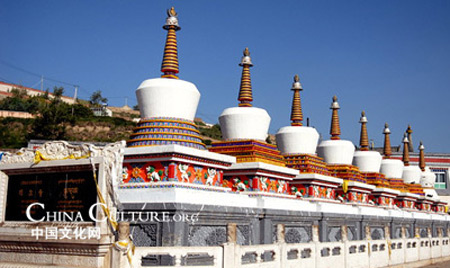
Photo shows the eight towers, symbolizing good luck, in the Tar Monastery, northwest China's Qinghai Province, photo from chinaculture.org.
The Tar Monastery, one of the six most important monasteries of the Gelug (Yellow Hat) Sect of Tibetan Buddhism, is a large complex featuring dozens of halls and towers on a mountainside in both Tibetan and Han architectural styles. Located in Huangzhong County, 25 kilometers from Xining, capital of Qinghai province, the monastery was built in 1560 in honor of the founder of Gelug Sect, Tsongkhapa. It's known for its many butter sculptures, mural paintings and barbolas (piled-up embroidery), which fully demonstrate the artistic style and skill of Tibetan culture.
Butter sculptures
Traditionally, Tibetan butter sculptures are displayed on monastery altars and family shrines as offerings. The butter sculptures originated in Tibet and were introduced to the Tar Monastery in the early 17th century. Many monks in monasteries in China make butter sculptures, but those of the Tar Monastery excel in technique and scale. Butter sculptures cover a broad range of themes, but mostly, they center on Buddhism, historic stories, Buddha, personal biographies, flowers, birds, fish, insects, and pavilions. Often the sculptures are part of a series that depicts a story, such as the life of Sakyamuni.
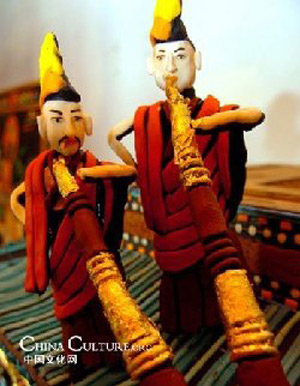
Photo shows the butter sculpture taking shape of lama, photo from chinaculture.org.
The making of a butter sculpture is itself a daunting task. As butter made from yak milk melts in warm weather, butter sculptures have to be made by hand during the coldest months of the year, usually from October to January. As time goes on, they are imbued with the trends of the times. For example, the butter sculpture "The Story of Sakyamuni" not only enriched the traditional style of butter sculpting, but also reflects real life. In this way, the former singular method has evolved into a multi-method system, including a combination of stereoscopic sculptures and relief -- a combination of single sculptures and multi sculptures.
In a group of butter sculptures, a pavilion, a Buddha or an arhat may be as high as several meters; and a flower, a bird, an insect and a fish may be as small as three to five centimeters. All of them are lifelike.
Deformities begin appearing above 15 degrees Centigrade and the sculptures begin to melt at 25 degrees Centigrade. With a view of guaranteeing the quality, the monks need to dip their hands in freezing water from time to time. This is why they tend to suffer from arthritis and some become crippled. Their contribution to Buddhism is really incredible.
Mural paintings
The Tar Monastery contains countless murals. There are numerous large-sized colorful and vivid mural paintings in the Great Temple of Golden Tiles, the Great Scripture Hall and the Small Scripture Hall.
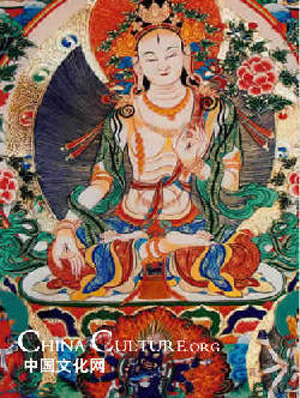
Photo shows a fesco painted with Buddhist image in the Tar Monastery, northwest China's Qinghai Province, photo from chinaculture.org.
The murals are done directly on walls and beams, but in most cases on fabrics. A kind of stony mineral dye is used in painting to keep pictures fresh for hundreds of years.
The murals are rich in content and elegant in style. Most of them depict Buddhism stories. Figures in the murals are in different postures, looking extremely true to life. The pictures of the image of flying Bodhisattva clad in transparent fine gauze are the masterwork among the temple murals. Mountains and rivers, flowers and trees, pavilions and terraces fit well together, displaying a serene landscape.

Photo shows a a mural painting collected in the Tar Monastery, photo from chinaculture.org.
Barbolas
They are made of colorful silk-fabric cuttings. These cuttings in the shape of Buddha, man, flower, plant, bird, wild animal, insect, fish etc. are sewn on a large silk fabric, in-between stuffed with wool, cotton or other woolly materials, to achieve a three-dimensional effect.
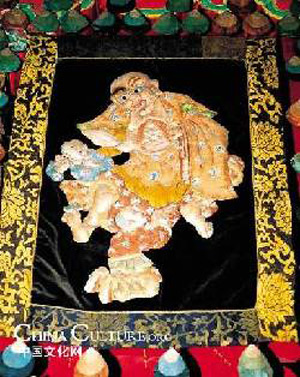
Photo shows a piled-up embroidery work, photo from chinaculture.org.
The oblong sheets or streamers of silk fabric with barbolas of Buddha, scripture etc. hang from the ceilings or upon pillars all over the places in the monastery. They constitute a dazzling silk gallery. Artists of barbolas pay particular attention to projecting the lines and contours of an individual figure. This fully demonstrates the artistic style and skill of Tibetan culture.
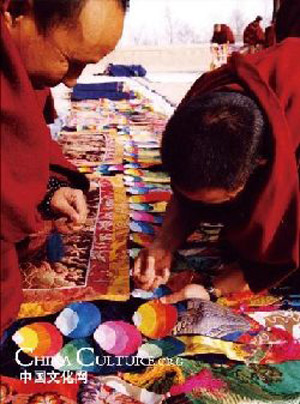
Photo shows monk artisans in the Tar Monastery making barbolas, photo from chinaculture.org.
Two large-sized barbolas are hung on the wall of the Great Scripture Hall, with one focusing on the story of 16 disciples of the Buddha Sakyamuni and the other the Chinese legend of Eight Immortals Crossing the Sea.
